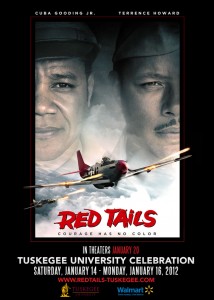(ThyBlackMan.com) The Tuskegee Airmen were the quintessential credits to their race when disproving racist stereotypes was considered a part of every respectable black person’s job description. It’s unreasonable, when you think about it, to expect one person or even a group of 1,000 to disprove all the negative opinions being expressed about the larger group. Unreasonable, in large part, because such opinions aren’t driven by facts in the first place.
While growing up I always heard that none of the 1,000 pilots perished during the war, that despite flying more than 15,000 sorties, they all survived. The  truth is 66 of the 1,000 died. That’s an incredible success rate by any measure, but the fact that even that success was exaggerated reveals a sad but common belief that the only way to expose the awfulness of racism is to be unfailingly perfect.
truth is 66 of the 1,000 died. That’s an incredible success rate by any measure, but the fact that even that success was exaggerated reveals a sad but common belief that the only way to expose the awfulness of racism is to be unfailingly perfect.
The Tuskegee Airmen weren’t perfect, but they came about as close to it as any group of warriors ever has. “Red Tails,” the film that hits movie screens today, showcases those pilots who, as a National WorldWorld War II Museum official put it, fought fascism abroad only to come back home to a segregated society.
Clem Goldberger, an associate vice president at the museum, said Thursday that the museum is currently building its U.S. Freedom Pavilion, which is scheduled to open in November. Museum officials expect that early next year, they will be able to move into that new building a restored P-51 with a red tail, just like the one the Tuskegee Airmen flew.
In the meantime, museum visitors can come see the uniforms worn by African-American units during the war: not just the Tuskegee Airmen, she said, but also those worn by the “Red Ball Express, supply line truck drivers that delivered 12,000 tons a day to an Allied Army that was advancing across France.”
At noon on Feb. 15, digital education coordinator Gemma Birnbaum will give a free “lunch box lecture” called “Double Victory: Black WWII Veterans and the Struggle for Civil Rights.” On Feb. 25, children between the ages of 8 and 12 who are accompanied by a parent will be able to come to the museum and build model P-51s.
Goldberger said the museum has a treasure trove of information on its website, too, including three lesson plans specific to the experiences of black soldiers.
George Lucas is the executive producer of “Red Tails.” In a Jan. 9 interview on The Daily Show, Lucas told host Jon Stewart that he financed the movie himself. Hollywood denied him money for the project because “it’s an all-black movie. There’s no major white roles in it at all. It’s one of the first all-black action pictures ever made.”
Reason enough, apparently, for studio executives to deny Lucas — one of the most profitable movie makers ever — go-ahead money for this picture. If the creator of “Star Wars” and “Indiana Jones” can’t get money to shine a positive light on black subjects, what chance do young upstarts have?
When the D-Day Musuem — as it was then called — opened with a parade of veterans on June 6, 2000, critics were right to complain about the near absence of black servicemen and women who were feted. This newspaper’s editor also expressed regret that the paper’s coverage of the opening contributed to the idea that all the war’s heroes were white. The following February a 3-day symposium recognizing black contributions to the Allied victory was put together by the museum, Tulane’s Amistad Research Center, the Center for African and African-American Studies at Southern University at New Orleans and the Eisenhower Center for American Studies at the University of New Orleans.
Since then museum officials appear to be more careful about distributing the praise. During our Thursday conversation, Goldberger said, “Courage has no color.” She said she got the quote from actor Wendell Pierce, “a great friend of the museum” whose father fought in the war.
No, courage doesn’t have a color, although when you go to the movies it can be hard to tell. How is Hollywood still resistant to showing black heroes when such heroics are 70 years in our past?
Written By Jarvis DeBerry
Official website; http://timespicayune.com
















Leave a Reply